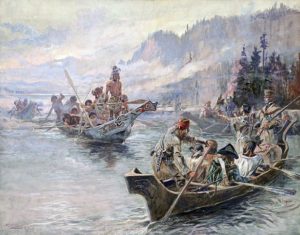Thank you for stopping in to check out facts about Lewis and Clark. However, before we get into some facts, let’s take a little look at his background.
Captain Meriwether Lewis was born on August 18, 1774, in Ivy, Virginia. In 1804, he would join Lieutenant William Clark, born August 1, 1770, in Ladysmith, Virginia, on one of my most famous voyages in American history. The Lewis and Clark expedition started in the city of St. Louis on May 14, 1804, and would not return home until March of 1806. To keep learning about the Lewis and Clark expedition, continue reading the facts below!

Interesting Facts about Lewis and Clark
1. The Lewis and Clark expedition happened because of Thomas Jefferson.
In 1803, President Thomas Jefferson bought a large amount of American land from France. This purchase would become known as the Louisiana Purchase. Because Jefferson had no idea what the land held, he commissioned two men, Meriwether Lewis and William Clark, to lead an expedition to find out what they could about the land.
2. There were over 40 men on the expedition.
It was not just Lewis and Clark who took part in the expedition to explore the western lands. There were over 40 men who took part in the journey, and they all had their own jobs. For example, some men were in charge of taking notes while other men were in charge of handling various jobs along the route. They called themselves the Corps of Discovery.
3. Lewis served as secretary for Thomas Jefferson.
When Thomas Jefferson became president in 1801, he asked Lewis to leave the army and come work for him as his secretary in the White House. Lewis accepted the invitation and became Jefferson’s secretary until the Lewis and Clark expedition.
4. They knew each other before the expedition.
They first met in the army in 1795 when Lewis was court-martialed for supposedly challenging a lieutenant to a duel. Lewis was found not guilty but sent to a different army camp so there would be no issues. Lewis’ new lieutenant was Clark.
5. Clark’s personal slave joined him on the expedition.
One of the other men on the expedition was Clark’s slave, York. Through the expedition, York became a valued member of the Corps of Discovery because he had some of the best hunting skills out of all the men. In fact, when the men of the expedition were trying to decide where to set up camp during the winter of 1805, they allowed York to have a vote.
6. The Corps of Discovery had 200 pounds of gunpowder and an experimental rifle.
Because the Corps of Discovery and Thomas Jefferson had no idea what was on the new American lands, they made sure they were well prepared for anything. In fact, the Corps of Discovery brought with them one of the largest arsenals in history west of the Mississippi River. Along with the 200 pounds of gunpowder, they had 400 pounds of lead for bullets and a pneumatic rifle which could shoot 20 rounds of bullets after being compressed with air.
7. Sacagawea joined in on the expedition.
Probably one of the most well-known facts about the Lewis and Clark expedition is that teenaged Shoshone Indian, Sacagawea, helped the expedition. Taken from her tribe years before, she brought her husband and newborn son as they joined the expedition during the winter of 1804. During the rest of the travels, Sacagawea served as an interpreter when the expedition ran into other Native American tribes.
8. One member of the Corps of Discovery died during the expedition.
This is one of the surprising fact about Lewis and Clark expedition. Only one member of the Corps of Discovery died during the voyage. Considering the harsh conditions of winter and the fact that they were in unknown territory dealing with snake bites and other wild animals, it is surprising that no one else perished on the journey. The one who did was Sergeant Charles Floyd, who died in August of 1804 from what many believe was a burst appendix.
9. Clark adopted Sacagawea’s children.
During the expedition, Clark came to care for Sacagawea’s son Jean Baptiste. When she left the expedition, he offered to adopt Jean and raise him as his own, but Sacagawea refused. However, she did allow Clark to pay for Jean to get an education. Then in 1812, when Sacagawea passed away, Clark became the legal guardians of Jean Baptiste and Lisette, who she gave birth to after the expedition.
I hope that you have enjoyed learning more about Lewis and Clark facts. Please take a look at historical figures page to see other significant people in history.
